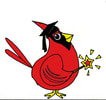|
|
|
|
Johann Strauss, Jr. was an Austrian composer of light dance music who helped make the waltz popular. He wrote over 500 waltzes and other types of dance music during the 19th century.
Johann Strauss, often referred to as Johann Strauss II or "the Younger," was born on October 25, 1825, in Vienna, Austria. He was the oldest son of Johann Strauss (the Elder), also a composer, but one whose reputation would eventually be eclipsed by his son's. |
|
Strauss the Elder wanted his son to follow a different career path than he himself had followed, so Strauss II became a bank clerk while secretly studying the violin with a member of his father's company. His father left the family when Strauss was 17, and Strauss soon began openly embracing the musician's life, conducting a band in a Viennese restaurant when he was still a teenager, in 1844.
|
|
|
|
|
Johann Strauss, the Younger, was a very famous, and successful, but he also knew the pain of failure. Yesterday’s listening example, “The Blue Danube”, was a total flop when first performed in 1867. The audience hated the lyrics. Never one to give in to defeat, later that year at the Paris International Exposition, Johann performed it as an instrumental piece and it became a smash hit.
|
|
A year after the restaurant appearance, Johann Strauss formed his own band and suddenly found himself competing with his father. He also began writing at this point—quadrilles, mazurkas, polkas and waltzes, which were then performed by his orchestra. He soon began receiving praise for his work and, in 1845, was awarded the honorary bandmaster position of the 2nd Vienna Citizens' Regiment. (To shed some light on the competition between father and son, Strauss the Elder was bandmaster of the 1st regiment.)
|
|
|
|
Johann made his American debut in 1872 as part of the The World Peace Jubilee, an event with more than 2,000 musicians and 20,000 singers. Today, he and his music remain favorites all over the world. The Johann Strauss Orchestra, a modern incarnation of his own Strauss Orchestra, was established by world-renowned violinist, Andre Rieu, in 1987.
|
|
In 1853, Strauss fell ill, and his younger brother, Josef, took control of the orchestra for six months. After recovering, he dove back into conducting and composing activities—a pursuit that proved to be stronger than ever, gaining the eventual attention of such luminaries as Verdi, Brahms and Wagner. Strauss Jr. eventually surpassed his father's fame, and became one of the most popular waltz composers of the era, extensively touring Austria, Poland and Germany with his orchestra.
|
|
|
|
|
Johann Strauss II’s success and popularity eclipsed his father’s. But the son often played Johann Senior’s works and openly declared his admiration of them, although it was no secret to the Viennese that their rivalry was intense. In 1855, Strauss accepted commissions from the management of the Railway Company of Saint Petersburg to play in Russia for the Vauxhall Pavilion at Pavlovsk in 1856. He would return to perform in Russia every year until 1865.
|
|
Later, in the 1870s, Strauss and his orchestra toured the United States, where he took part in the Boston Festival at the invitation of bandmaster Patrick Gilmore and was the lead conductor in a "Monster Concert" of over 1000 performers performing his "Blue Danube" waltz, amongst other pieces, to great acclaim.
|
|
|
|
|
Together with his brothers Josef and Eduard, Johann had complete control of the balls and concerts in the houses of the rich people in Vienna. Wherever he went he was surrounded by lots of admirers. His waltzes are still as popular as ever, and millions of people in different countries hear them on television on New Year's Day when they are played by the Vienna Philharmonic Orchestra at their traditional New Year’s Day concert.
|
|
|
|
